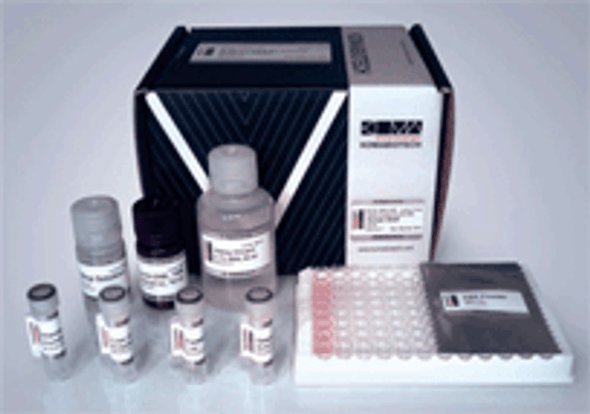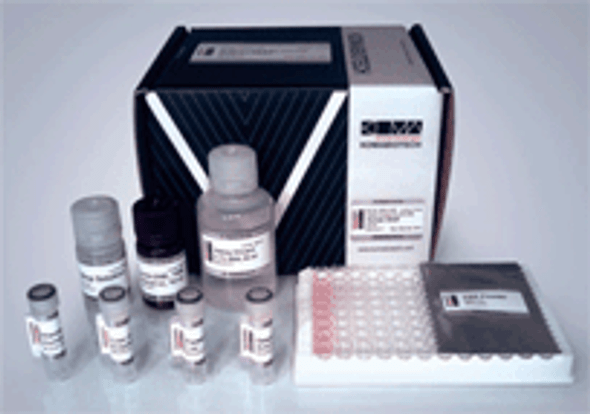Description
Reactivity: Mouse, Rat
This ELISA kit is used for quantitative determination of total mouse/rat CRF in its plasma and brain extract samples. The kit is characterized by its sensitive quantification and high specificity. In addition, it is not influenced by other constituents in samples. Standard antigen, CRF, of this kit is a highly purified synthetic product (purity: higher than 98%). Supplementary: Sandwich
Applicable Sample: Plasma, Brain Tissue Extract
Other: Corticotropin releasing factor (CRF, also CRH) was initially isolated from ovine hypothalamus by Vale et al., in 1981, and identified as a novel neuropeptide comprising 41 amino acid residues with molecular weight 4758. Later human CRF and rat CRF were also isolated and identified. The mouse CRF peptide is identical at amino acid level to the rat and human CRF peptides. CRF in anterior pituitary promotes the synthesis and secretion of ACTH, a main factor of hypothalamus-pituitary-adrenal (HPA) axis. In the rat and human, CRF distributes mainly in hypothalamus, but it was also found in spinal cord, stomach, spleen, duodenum, adrenal and placenta. Inaddition, immunochemical evidence supported the wide distribution of the peptide throughout the central nervous system (CNS) such as olfactory bulb, retina and central auditory system in the rat. In mouse brain extracts, the highest concentrations ofCRF-like immunoreactivity (CRF-LI) has been detected in median eminence and hypothalamus and also existing in amygdala, thalamus, frontal cortex, medulla/pons and cerebellum by radioimmunoassay. However because of the wide distribution, it is stilldisputing about CRF whether its blood level can reflect only the function of HPA axis.
The relationships between CRF and stress, CRF and Alzheimer disease (AD) were attracted much attention recently. In fact the peptide was also suggested to regulateendocrine, autonomic and behavioral responses to stress, based on an experiment with acute and chronic stress rat models that showed endocrine function changes similar to those seen in patients with depression 6.. CRF in serial cerebrospinal fluid(CSF) of patients with depression was strikingly reduced as compared to those of normal subjects. The mean CRF and ACTH levels in the CSF of AD patients were significantly lower than those of healthy controls. Only in the cortices of those with milddementia, CRF was reduced significantly. Thus CRF was proposed to serve as a potential neurochemical marker of early dementia and possibly early AD.
A large proportion of CRF in human brain was shown to be in the form of complex with its binding protein (CRF-BP). CRF molecule in the complex is unavailable for activation of the CRF receptor. Accordingly reduction in total CRF do not necessarily predict reduction of bioactive free CRF, and the levels of total CRF and CRF in the form of complex (CRF/CRF-BP) were suggested to be the main factors determining the quantity of bioactive free CRF in human brain. In AD there have been observed dramatic reduction in the content of free CRF in brain and thus displacement of CRF from CRF-BP was proposed asa possible treatment for AD. In primary neuron culture, CRF exhibited protective effect against cell death induced by amyloid-beta peptide, suggesting that disturbances in HPA axis function can occur independently of alteration in CRF mRNA levels inAD brain and further suggesting an additional role for CRF in protecting neurons against cell death. On the other hand, Yanaihara et al. demonstrated immunoreative CRF in various neuroendocrine tumors, and suggested that the blood level of the peptide might be used as a tumor marker.
All these information urge crucial importance of the measurement of CRF in brain especially of experimental animals not only for analysis of the function of CRF in CNS, but also for research in the fields of stress response and AD. We developed CRF-HS (high sensitivity) ELISA kit (YK131) in our laboratory, which is highly specific and sensitive quantification of mouse/rat CRF. The kit can be used for measurement of CRF directly in mouse/rat plasma andtheir brain tissue extracts with high sensitivity. (Special pretreatment of the brain tissue extract before assay is not necessary). It will be a specifically useful and convenient tool for CRF researches.
View AllClose
This ELISA kit is used for quantitative determination of total mouse/rat CRF in its plasma and brain extract samples. The kit is characterized by its sensitive quantification and high specificity. In addition, it is not influenced by other constituents in samples. Standard antigen, CRF, of this kit is a highly purified synthetic product (purity: higher than 98%). Supplementary: Sandwich
Applicable Sample: Plasma, Brain Tissue Extract
Other: Corticotropin releasing factor (CRF, also CRH) was initially isolated from ovine hypothalamus by Vale et al., in 1981, and identified as a novel neuropeptide comprising 41 amino acid residues with molecular weight 4758. Later human CRF and rat CRF were also isolated and identified. The mouse CRF peptide is identical at amino acid level to the rat and human CRF peptides. CRF in anterior pituitary promotes the synthesis and secretion of ACTH, a main factor of hypothalamus-pituitary-adrenal (HPA) axis. In the rat and human, CRF distributes mainly in hypothalamus, but it was also found in spinal cord, stomach, spleen, duodenum, adrenal and placenta. Inaddition, immunochemical evidence supported the wide distribution of the peptide throughout the central nervous system (CNS) such as olfactory bulb, retina and central auditory system in the rat. In mouse brain extracts, the highest concentrations ofCRF-like immunoreactivity (CRF-LI) has been detected in median eminence and hypothalamus and also existing in amygdala, thalamus, frontal cortex, medulla/pons and cerebellum by radioimmunoassay. However because of the wide distribution, it is stilldisputing about CRF whether its blood level can reflect only the function of HPA axis.
The relationships between CRF and stress, CRF and Alzheimer disease (AD) were attracted much attention recently. In fact the peptide was also suggested to regulateendocrine, autonomic and behavioral responses to stress, based on an experiment with acute and chronic stress rat models that showed endocrine function changes similar to those seen in patients with depression 6.. CRF in serial cerebrospinal fluid(CSF) of patients with depression was strikingly reduced as compared to those of normal subjects. The mean CRF and ACTH levels in the CSF of AD patients were significantly lower than those of healthy controls. Only in the cortices of those with milddementia, CRF was reduced significantly. Thus CRF was proposed to serve as a potential neurochemical marker of early dementia and possibly early AD.
A large proportion of CRF in human brain was shown to be in the form of complex with its binding protein (CRF-BP). CRF molecule in the complex is unavailable for activation of the CRF receptor. Accordingly reduction in total CRF do not necessarily predict reduction of bioactive free CRF, and the levels of total CRF and CRF in the form of complex (CRF/CRF-BP) were suggested to be the main factors determining the quantity of bioactive free CRF in human brain. In AD there have been observed dramatic reduction in the content of free CRF in brain and thus displacement of CRF from CRF-BP was proposed asa possible treatment for AD. In primary neuron culture, CRF exhibited protective effect against cell death induced by amyloid-beta peptide, suggesting that disturbances in HPA axis function can occur independently of alteration in CRF mRNA levels inAD brain and further suggesting an additional role for CRF in protecting neurons against cell death. On the other hand, Yanaihara et al. demonstrated immunoreative CRF in various neuroendocrine tumors, and suggested that the blood level of the peptide might be used as a tumor marker.
All these information urge crucial importance of the measurement of CRF in brain especially of experimental animals not only for analysis of the function of CRF in CNS, but also for research in the fields of stress response and AD. We developed CRF-HS (high sensitivity) ELISA kit (YK131) in our laboratory, which is highly specific and sensitive quantification of mouse/rat CRF. The kit can be used for measurement of CRF directly in mouse/rat plasma andtheir brain tissue extracts with high sensitivity. (Special pretreatment of the brain tissue extract before assay is not necessary). It will be a specifically useful and convenient tool for CRF researches.






